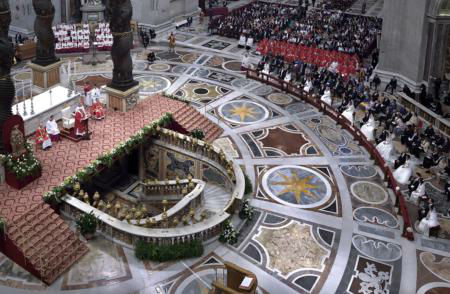The Synod and the Real Crisis of Marriage
Expectations and anxieties regarding next month's assembly in Rome of the world Synod of Bishops are running exceptionally high. The subject matter alone--the crisis of marriage and family--would be reason enough for that. But there's a lot else going on here.
Pope Francis helped create this situation by hinting at the possibility of some sort of change in the Church's practice of denying communion to divorced and remarried Catholics whose first marriages haven't been annulled. Some people would welcome that--in some cases, because they consider it an opening to other changes they want--while others see it as a threat to the indissolubility of marriage.
Recently the general secretary of the Italian bishops' conference, Bishop Nunzio Galantino, kept the pot boiling by calling "exclusion from the sacraments" too high a price for Catholics in "irregular unions" to pay. Yet people in this position have access to at least one sacrament--the sacrament of penance, under the usual conditions--if they care to use it.
Now it's the turn of the October 5-19 synod assembly, bringing together 253 presidents of bishops' conferences and other church leaders. But already the advance attention devoted to a relatively small number of people has been a distraction from the larger crisis of marriage that exists in many places. The divorced and remarried do deserve attention of course, but so does much else.
The crisis of marriage can be seen in statistics from the United States where the percentage of married adults fell from 68% in 1950 to little more than half in 2012 and births to unmarried women now are more than 40% of the total. By no means is the U.S. alone though. Over the past decade marriage rates in most European countries, including traditionally Catholic ones, have fallen sharply. Last year Italy recorded the fewest marriages in a century.
The disturbing trends also are present among American Catholics. In 2003, with U.S. Catholic population at 66 million, there were more than 242,000 Catholic marriages and over a million infant baptisms; last year, with 3 million more Catholics, marriages numbered 164,000 and baptisms totaled 763,000. That's a drop of 78,000 marriages and 240,000 baptisms.
Economic and cultural factors have combined to produce these results. So what can the synod do about it?
The assembly's working document, summarizing input from bishops and others worldwide, repeatedly stresses the need for more teaching and better explanation of Catholic doctrine on matters like the sanctity and indissolubility of marriage and sexual morality, and the serious obligations they give rise to. The teaching and explaining are necessary not only in marriage preparation courses but also in Catholic schools and religious education, as well as from the pulpit and in church-related media.
This is easily said--and no doubt will be said often at next month's synod--but not so easy to do, especially in the face of a secular culture and secular media busily disseminating very different messages about all these matters. One obvious consequence is that the Church needs to instruct Catholic homes in becoming domestic counter-cultures--family enclaves consciously committed to the transmission and living out of gospel values.
This year's synod assembly is a step in a process. There will be a second assembly in October 2015 charged with formulating specific recommendations. That will be followed, probably in early 2016, by a post-synod document from the Pope. Here's hoping concern for the problems of people in "irregular unions" doesn't get in the way of seeing the larger picture.
- Russell Shaw is the author of more than twenty books. He is a consultor of the Pontifical Council for Social Communications and served as communications director for the U.S. Bishops.



















